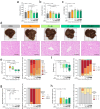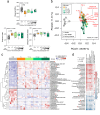Ginger essential oil prevents NASH progression by blocking the NLRP3 inflammasome and remodeling the gut microbiota-LPS-TLR4 pathway in mice
- PMID: 39152116
- PMCID: PMC11329514
- DOI: 10.1038/s41387-024-00306-1
Ginger essential oil prevents NASH progression by blocking the NLRP3 inflammasome and remodeling the gut microbiota-LPS-TLR4 pathway in mice
Abstract
Background: Diet and gut microbiota contribute to non-alcoholic steatohepatitis (NASH) progression. High-fat diets (HFDs) change gut microbiota compositions, induce gut dysbiosis, and intestinal barrier leakage, which facilitates portal influx of pathogen-associated molecular patterns including lipopolysaccharides (LPS) to the liver and triggers inflammation in NASH. Current therapeutic drugs for NASH have adverse side effects; however, several foods and herbs that exhibit hepatoprotection could be an alternative method to prevent NASH.
Methods: We investigated ginger essential oil (GEO) against palm oil-containing HFDs in LPS-injected murine NASH model.
Results: GEO reduced plasma alanine aminotransferase levels and hepatic pro-inflammatory cytokine levels; and increased antioxidant catalase, glutathione reductase, and glutathione levels to prevent NASH. GEO alleviated hepatic inflammation through mediated NLR family pyrin domain-containing 3 (NLRP3) inflammasome and LPS/Toll-like receptor four (TLR4) signaling pathways. GEO further increased beneficial bacterial abundance and reduced NASH-associated bacterial abundance.
Conclusion: This study demonstrated that GEO prevents NASH progression which is probably associated with the alterations of gut microbiota and inhibition of the LPS/TLR4/NF-κB pathway. Hence, GEO may offer a promising application as a dietary supplement for the prevention of NASH.
© 2024. The Author(s).
Conflict of interest statement
The authors declare no competing interests.
Figures






References
Publication types
MeSH terms
Substances
Grants and funding
- 111-2628-B-002-047/Ministry of Science and Technology, Taiwan (Ministry of Science and Technology of Taiwan)
- 109-2327-B-002-005/Ministry of Science and Technology, Taiwan (Ministry of Science and Technology of Taiwan)
- 109-2314-B-002-064-MY3/Ministry of Science and Technology, Taiwan (Ministry of Science and Technology of Taiwan)
- 110-2327-B-002-007/Ministry of Science and Technology, Taiwan (Ministry of Science and Technology of Taiwan)
- 111-2327-B-002-008/Ministry of Science and Technology, Taiwan (Ministry of Science and Technology of Taiwan)
LinkOut - more resources
Full Text Sources
Medical

